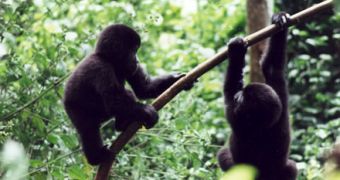It seems that not everything about Tarzan is a complete invention. Researchers at the University of Sussex discovered remarkable similarities between the way humans and gorillas use their body language to communicate their emotions. Facials expressions denote the exact feelings both species experience at the moment. Because they are not able to talk, gorillas use huddling and grooming to establish complicated hierarchical relationships within their groups.
Anthropologists believe that the behavior they've observed primates exhibit may be similar to the one early humans used millions of years ago. On the grander scheme of things, the moment we separated from apes on the evolutionary scale is very close, nearly 6 million years ago. It's very likely that humans learned to speak by continuously exercising their communicational skills, which were most certainly derived from gestures and expressions.
Biologists confirmed that gorillas, like humans, use their left side of the brain to communicate, regardless of the fact that they are not able to speak articulately. However, some argue that primates developing language skills is just a matter of time. Naturally, time is a relative matter, so we could be looking at tens of thousands to millions of years, assuming another extinction doesn't occur in the foreseeable future.
Psychologists say that the new discovery could hold the key to humans learning to better communicate with those suffering from autism or other forms of speech impairment. As a result, a new study on 2 to 4 year-olds is underway, with the purpose of determining new ways of reaching children who cannot speak normally and who need to express themselves nevertheless.
"I hope it will lead to better diagnoses of conditions such as autism and the creation of new health and education programs to help these children at an early stage," said psychologist Dr Gillian Sebestyen, who is currently leading the study on infants.

 14 DAY TRIAL //
14 DAY TRIAL //